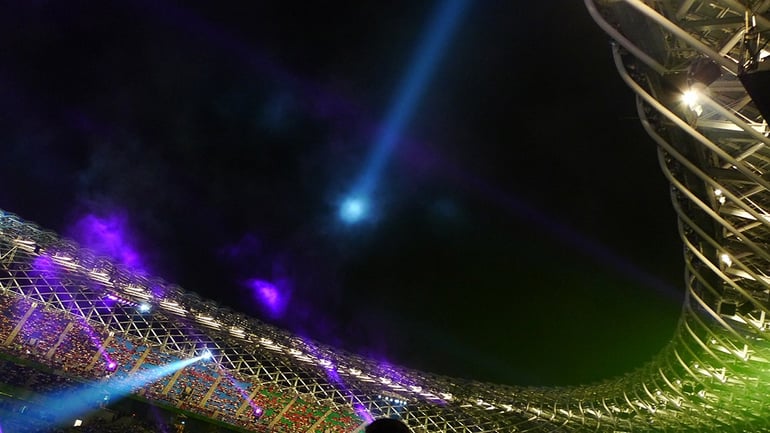
The spectrum we use—the UHF broadcast band—is going away, and the devices we operate—analog FM radios—are ill-equipped for the digital and database controlled ecosystems they are increasingly asked to inhabit.
Wireless microphone manufacturers are innovating, and end-users are changing how they deploy equipment for greater efficiency. But those changes won’t come fast enough. It is of great importance that regulators give wireless audio devices a gradual, lengthy transition out of UHF spectrum and, eventually, new spectrum elsewhere that is either exclusively for wireless audio, or can be shared with other devices without sacrificing the technical requirements demanded by our applications.
Making the case for why regulators should do that is difficult.
Although wireless audio devices are genuinely valuable, their user base is small when compared to other users, like cellular, and the value of wireless audio is harder to concretely quantify than the monetary value the incentive auctions will ascribe to UHF frequencies through free market forces—which does not mean that value does not exist.
Purely monetary arguments are bound to come up short, because we essentially have to make the case that a handful of wireless mics should be able to use spectrum worth billions of dollars to someone else for free, while other types of users, like LPTVs, are given the boot.
For wireless audio to move forward, we must communicate to regulators why wireless audio devices—the type we use right now—are uniquely indispensable to corporations, governments, non-profits, and society as a whole.
If you peel back the layers of rhetoric that have bounced around since the auction of the 700 MHz band a few years ago, you realize the case for wireless microphones doesn’t have much to do with the devices themselves, but rather the context in which they’re used: live events.
To understand why wireless microphones are important, you have to understand why live events are important, not just to the industries that produce them, but to everyone.
Those who work in the industry carry this knowledge implicitly. What we do is important. Right? It’s so inherent and obvious, that I think at times nobody thinks to state the obvious, because we assume it has been said before.
But if we are to be successful, we have to make that implicit knowledge explicit, and legible, to regulators, to everyone, and deeply explore why live events—of which wireless audio is an integral part—are valuable, ensuring that we look beyond easy definitions of “value” to include the other, non-tangible, but still real forms of value.
So, why do live events matter? Let me count the ways.
Proximity in the Internet Age
Digital media platforms and social networks have changed the way people everywhere perceive reality, and the way organizations do business.
The broken record spins: many of our interpersonal interactions now occur online. How does this bode for the “real” world, of handshakes and eye-contact?
Since the dawn of IT, pundits have predicted the decay of face-to-face interactions and events due to modern communications, and the rhetoric has not stopped. Forums, social media networks, Youtube, etc, suffer straw man arguments that point to digital interactions as the root of poor social skills and isolation.
And yet, face-to-face is not dead, or dying.
To the contrary, face-to-face is at a premium.
Corporations invest ungodly sums in lavish spaces that encourage “spontaneous interactions” between talented employees.
Urban life has exploded into a new golden age in every country.
Corporate events keep growing in complexity and scale, and trade shows are still a crucial part of marketing strategies.
Pollstar, which tracks the financial health of the concert industry, estimated that ticket sales to concerts and festivals reached $6.2 billion in 2014, up from $5.1 billion in 2013, and only $1.7 billion in year 2000. In fact Pollstar has reported staggering and nearly uninterrupted growth in the concert industry since 1990. And it’s not just because the music industry can’t make money selling records anymore. If concerts were overpriced, people wouldn’t go, and yet ticket prices have skyrocketed right alongside attendance!—from $41 in 2000 to $71 in 2014.
These days, organizations have so many different avenues for communicating a message and building a brand, but clearly still expend resources on the production of face-to-face gatherings because live events offer something that other forms of media and communications do not.
“There’s nothing that beats the live experience,” says Jim Kelley, Vice President of Industry Relations at PRG. “Face-to-face engagement is where the rubber meets the road, where you really start driving positive outcomes. Human beings like to be engaged with other human beings, whether that’s at a meeting or a concert.”
There is something inherent about face-to-face that ensures its relevancy as long as people continue being people.
But there is also something qualitatively different about why people go to live events in a contemporary, digital society that explains the quantitative growth.
Live events are powerful because they provide a caliber and quality of experience that digital mediums lack, one that is rooted in the “real.” A “real” life experience, especially one with others, is now a type of novelty, since we live so much of our routine lives alone in digital domains.
“There have been some studies that have shown the digital component has actually increased attendance at face to face events,” continues Jim Kelley. “In the sense that people are able to experience it and get their toes in the water and realize, ‘hey that was such a good experience online or digitally, that I now want to go experience the whole thing.”
Live events are where, suddenly, celebrities and leaders step out of fantasy to become an exhilarating physical object, previously existing only as a creature of shadow and color on a screen, or in memory. And to reinforce the existence of this new object are hundreds or thousands of other witnesses, all gathered within eyesight of one another around the same phenomenon.
Instead of keeping us isolated, for many, digital communication has had the counterintuitive effect of creating an impulse to come together. Gatherings are special and rare, and also foils of the digital mediums they complement.
Consequently, the expectations of audiences have risen; a spotlight and microphone are no longer enough. Central to meeting the expectation’s of today’s sophisticated audiences are the technically advanced and tightly coordinated entertainment technology products and services—wireless microphones and other audio devices among them—that make contemporary events so stimulating.
Live Events as Means of Production
We often think about the value of live events in terms of the money exchanged leading up to and during the event itself. And that is certainly one of the major and most easily measured kinds of value that live events offer. Construction companies are hired to build stadiums and theaters. Consultants and contractors and subcontractors and freelancers are hired and paid to coordinate and produce. Attendees pay for the event, and fan out before and after into surrounding communities, opening their wallets to local restaurants, bars, and parking garages.
But the value of live events does not end when the curtain closes. Many performances or presentations are professionally broadcast to a wider audience, or recorded for later rebroadcast, or diced, sliced, and blended into a dazzling variety and abundance of easily consumable free and paid entertainment products available across numerous digital and traditional channels, to be sold as a product, to increase a brand’s exposure and drive engagement, or to serve as fodder for news.
In other words, a major event (and all the technology used to put it on) is a kind of factory.
There is some monetary value in the actual event, but event stakeholders usually generate the majority of their revenues by producing entertainment products based off of that event, or by selling advertising slots appended to the event.
To illustrate this point, as an American, I have to jump straight to the NFL.
Bloomberg Business has called the NFL “the most popular show on TV and arguably the last totem of American mass culture,” whose revenues, though shrouded in mystery, may be somewhere north of $10 billion—which eclipses the total tax revenue collected by the country of Lithuania.
We like to think of football games as spontaneous play between honest contestants with a great deal at stake.
In reality, as much of what can be scripted is scripted and planned, to maximize theater that arises out of both anticipated and unanticipated turns of events within the game, which ultimately makes for a more compelling and watchable story, and therefore a more valuable product. The lenses of the cameras are carefully selected, the microphones are carefully coordinated and placed, the producers in the broadcast truck decide which feed should get pushed through, a broadcast mixer piping in the roar of the audience at key moments to heighten theatrical effect, etc…
What is so fascinating is that what is valuable is the continuity that is created between the real-time event and the ensuing entertainment products in the minds of consumers.
Sports broadcasts, and all the merchandised ephemera they generate, are worth paying for mostly because they take place in real time in front of a live audience of screaming fans. In fact, that may be the only reason they are worth paying for.
Sure, there is some importance in the characters who play on the field, and the way the game is played, as opposed to other games. But I think these differences only matter because they so happen to make the experience of watching sports live even more enjoyable.
Unlike something like, say, a theatrically released film, which has a beginning and an end, a football game is only one game of many games that serve to propel one of two teams onward to even greater victory in the future. At the end of the year, the game begins all over again. Football is such a powerful platform because it has no beginning and no end—only endless speculation, celebration, and analysis over relatively brief bursts of unpredictable live play.
Without the raw thrill of chance unfolding in real time on game-day, the discourse in-between games would not be nearly as intense, nor generate as many sales of TV subscriptions and merchandise. In-between games, you find a flurry of conversation and debate on past and upcoming games, on referee decisions, on the personal characters of certain players, on FM radio, AM radio, at the watercoolor, on ESPN. This stuff gets fans foaming at the mouth, so that when the actual game “the” game, is “on,” everybody is screaming and shouting as if their lives depended on it.
Literally they are screaming about a carefully branded entertainment product louder than anyone has ever screamed about anything, ever. Last year, the Kansas City Chiefs broke the record for loudest stadium in the world, measured at 142.2 dB—on par with a jet turbine, shotgun blast, or small explosion. The OSHA scale tops out at 140 dB, the “threshold of pain.”
Not only was the Kansas City Chiefs’ new world record a great way to violate OSHA noise safety standards, but it was also living proof of the power of live events.
Enough about OSHA. Let’s do a little thought experiment. What would happen if for some reason the NFL decided only to pre-record games for DVD distribution, and stopped letting fans into stadiums?
Wait, we actually don’t have to speculate.
This April, amid the tumult of the Baltimore riots, the Orioles played a baseball game without fans. As NPR reported, no baseball game has ever been broadcast without a live audience in the stands. The media almost universally described it as “surreal.”
Why?
The rules of the game were the same. A team won, and a team lost. Bright lights flickered on the billboards.
April’s “surreal” Orioles game gave the live event and entertainment industry a rare experimental treatment against controls; What happens to the quantitative and qualitative value of an entertainment product when there is no audience to enjoy it?—even though the nature of the game is unchanged?
I think it would be difficult to say that the absence of Oriole fans increased the value of the game. Certainly, 50,000 fewer tickets were sold, stadium staff did not come to work, and local restaurants and businesses never received an influx of game day business.
For the baseball fan watching at home, an otherwise carefully packaged, consistent product was suddenly missing a key ingredient—people—and, aside from some rubbernecking, probably suffered for it.
Without people, even the most expensive athlete transforms into a lunatic mime.
Without people, there is no proof that an event is enjoyed. That a brand stands for something. That a politician’s ideas are supported by a majority of voters.
If in some alternate universe the NFL’s stadiums were suddenly empty, American football would transform into a game of glorified chess played by large, muscular men, watched by almost no one.
I don't think these are trivial points. I’m making them because I want to show that the financial success of live entertainment products rest on fragile and (sometimes) non-obvious variables.
Whether attendees and television or digital viewers enjoy a live performance depends on their subjective impressions of the event—and those impressions depend in a large part on the perceived “liveness,” a sense of raw unfiltered reality and chance, of the thing in real time. A microphone dropout, an apathetic (or non-existent) audience, crew-members being unable to communicate on headset and missing a cue, a shaky or unfocused camera, and anything at all that interrupts the “instantaneous experience” of an event are not just frustrations or embarrassments, they severely damage the value of the product.
Access to UHF spectrum for wireless audio is one of the non-physical variables contributing value to one of America’s most important industries—entertainment products—and one of the strongest arguments for why it should be preserved for that purpose, even though the entertainment industry itself can’t match the communication industry’s bid for spectrum in an auction.
I was going to go on—go on to a third reason why live events are valuable, “Live Events as Displays of Power,” but, looking down at my watch, it’s time to stop. I may break this post up into three sections later on, and include that final reason as the third chapter.
Let me sign off with this:
Live events are not self-contained systems, and a lot of their worth is contained in intangibles, like emotional pleasure, social affiliation, and political clout—which are very real, but won’t show up in a spreadsheet.
For today’s high profile live events—the kind of sleek, seamless, coordinated ones which are valuable to large audiences, corporations, governments, and non-profits—wireless audio, and the spectrum that it uses, is not a needless luxury.
Wireless microphones, intercoms, and monitors are essential organs—kidneys, livers, spleens—that are required to maintain the illusion of instantaneous experience. They are not an appendix or earlobe which can be removed without consequence. The loss of just one threatens the existence of the organism as a whole, and when they operate at reduced capacity the health of the organism suffers proportionally.
It is—and will be—possible to change how those organs function—digital modulation, improved filtering, intelligent networking—that alter how efficiently wireless audio devices consume spectrum. But those changes won’t happen overnight.
Leading image courtesy Hsiung.


